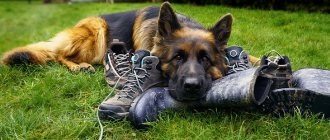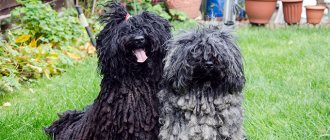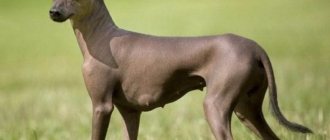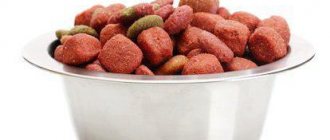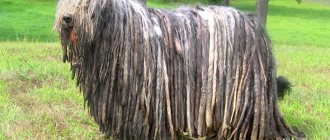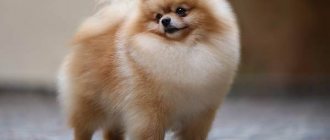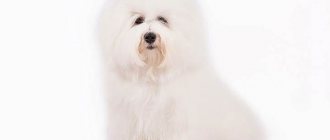Northern dog breeds are those pets that can easily withstand any climatic conditions and especially frost, they are hardy, have thick hair and a good sense of smell. Interestingly, many discoveries in the Arctic were made with the help of northern dogs and sled breeds. Because they were bred specifically for harness work.
It is important to understand that many of the northern dog breeds can be used as pets, but not in the south. After all, due to the thick fur and undercoat, it will be difficult for pets to withstand the heat. Especially if you want to use them as guards and hunters.
The most popular breeds are:
- Siberian Husky;
- Alaskan Malamute;
- Samoyed
Siberian Husky
The Siberian Husky is similar in appearance to the Malamute, but smaller. The breed was bred by breeders; previously they were used by the tribes of the north as hunting and sledding dogs, but with heavy loads. The name comes from the word “eski”, as the tribes of the Arctic were called. The peculiarity of the breed is that they are able to transport heavy loads over long distances. They also have blue eyes, thick fur and weigh up to 30 kg. At the moment the pet is used as a companion and circus dog for shows.
American Cocker Spaniel
Adult dog weight: from 7 to 14 kg. The height at the withers is from 34 to 39 cm. The friendly energy of this breed overflows. American cockers get along well with other animals and even play with kittens with pleasure.
The owner is perceived as God, they are ready to run after him to the very ends of the world. But cockers are not at all sensitive to birds, so if you already have a parrot, siskin or canary living at home, think carefully about whether you can provide the bird with the proper level of safety.
Among all types of medium-sized dog breeds, American Cockers stand out for their ears. You just want to pet them and pat them. The ears are thin, but covered with thick and long hair. These remarkable ears are especially loved by children, to whom cockers are quite friendly.
But you should not leave the baby alone with the dog: if carried away by the game, the cocker can grab it with its teeth, which is noticeable for the child. Even as they grow up, cockers continue to behave like not very smart puppies: they are hyperactive and so attached to their owner that the cocker’s company sometimes becomes too intrusive.
Alaskan Husky
The Alaskan Husky is still not included in the FCI classification, but it is considered the ancestor of the Siberian Husky. The breed itself appeared naturally and has much in common with the new northern husky, although it is slightly smaller in size, up to 25 kg. The tribes used the Alaskan husky for hunting and home guarding, and harnessed it to a sled. The coat is thick, gray, white, brown in color.
Greenlandshund
The Greenlandshund resembles a husky. This ancient breed is classified as a Spitz in the Fédération Cynologique Internationale classification. It is larger than Siberian Huskies, but smaller than Alaskan Malamutes. At home, she transported cargo and helped hunt polar bears, seals and fur seals. Dogs took part in many northern journeys, especially in the expeditions of the polar explorer F. Nansen. They withstand harsh living conditions thanks to their two-layer fluffy wool.
Over the course of many centuries, dogs have retained and developed excellent working qualities: reliability, strength, endurance, excellent intuition and sense of smell, and unmistakable orientation. They prefer to live and work in a pack. If the authority of the owner is indisputable, then the husky will protect him and show devotion. Despite their strong-willed nature, Greenlandshunds are balanced, cold-blooded and friendly.
Alaskan Malamute
The Alaskan Malamute was bred in the north by wild tribes more than three thousand years ago, among its ancestors is the polar wolf. The name comes from the name of the Malemute tribe. They were used for riding in a sled, transporting cargo and protecting homes. The coat is thick with undercoat, color is wolf. The pet requires attention and constant physical training.
Samoyed dog
Samoyeds are one of the most popular dogs in the world; their appearance resembles a cute bear. The name comes from the Samoyed tribe. Previously used for herding animals, they rarely took part in riding. Only after the start of expeditions to the Arctic, the Samoyed dog began to be used in sled riding. The breed is distinguished by its endurance, activity, and unpretentiousness in the matter of nutrition. The coat is fluffy white, average size – up to 30 kg.
Eurohound
- Height: from 50 to 65 cm
- Weight: from 18 to 24 kg
- Life expectancy: 12 to 15 years
- Temperament: playful, affable, alert, friendly, intelligent, active
The Eurohound, or Scandinavian hound, is the lightest dog breed on our list, weighing only 18-24 kg. While Eurohounds may not be as good at carrying people as larger breeds of sled dogs, they often make excellent farm helpers, pulling sleds of goods and supplies. Eurohounds have a lot of strength and energy and love long hours of work . They make excellent pets, but you will need to set aside at least an hour a day to ensure your Eurohound gets the activity it needs to stay healthy.
Karelian Bear Dog
Externally, the Karelian Bear Dog has much in common with the Russian Laika, although this breed is much more common. Used for hunting, tracking large animals and home protection. An excellent sense of smell and hunting qualities are genetically determined, but a bear dog needs to be raised and trained constantly. The coat is thick, fluffy, and red in color.
Thai Ridgeback
Adult dog weight: from 23 to 32 kg. The height at the withers is from 56 to 66 cm. This breed is definitely not suitable for novice dog breeders. The independent and stubborn nature of the Thai makes the training process difficult, so beginners will not be able to cope.
Dogs have high intelligence, but achieving unconditional obedience from them can be quite problematic. But if you are ready to show patience, love and affection, the Thai will become a loyal friend, a good guard and a true family member.
Purebred Thai Ridgebacks are quite rare. The breed, although ancient, is not widespread outside its historical homeland. Strong, fearless Ridgebacks are highly valued by breeders, so you will have to pay a pretty penny for a puppy.
When getting a Thai Ridgeback, be prepared for many hours of walks in parks and constant contact with your pet. Thais cannot stand loneliness and boredom. Accept your pet for who he is - you still can’t change his innate character. If you insist, you risk getting a dog with serious mental problems.
For the same reason, you cannot shout at Thais - their subtle mental organization does not allow manifestations of rudeness; a Ridgeback can be very offended by such freedom towards itself. Only affection, love and patience can raise a Ridgeback puppy into an obedient dog with a balanced character.
Yakut Laika
The Yakut Laika appeared in the north-east of Russia in the area of “dog rivers”. Pets were used for sledding and hunting large animals. Externally, the Yakut Laika has a medium size, strong paws, thick coat of spotted color (white-black, black-red). The pet easily tolerates any climatic conditions and is quite hardy.
https://youtu.be/ugnGhpr9wLw
Greenland sled dog
The Greenland sled dog is a rather rare breed in our time; it originated in Greenland and was used for sled riding and hunting. Outwardly, it is a strong, hardy, muscular dog. The coat is thick, the color is white, spotted, gray, brown. The peculiarity is that the Greenland sled dog adapts to all living conditions, but it is better not to keep it in an apartment.
Read: Dog breeds for apartments.
Education and training
A beginner cannot cope with raising and training a Greenlander on his own. It is better to contact a dog handler. Experience with sled dogs or at least other breeds is required. Greenlanders are trained in a sled dog training program.
The Greenland dog is a very strong character and independent animal that is guided only by its instincts. It is impossible to forcibly instill skills in primitive dogs, only on full terms, taking into account the benefits of both parties.
Greenland dogs are quite difficult to train.
The Greenlander was used to living in a pack where there was a constant struggle for the place of leader. If there are other animals in the house, the pet can become the instigator of a quarrel. The owner’s family is also perceived as a flock
Therefore, from the very first days of the dog’s appearance until the end of the dog’s life, it is important to prove your leadership.
The Greenlander does not tolerate humiliating punishment, aggression, or deception. May be stubborn and disobedient. Learning will require a lot of time and patience.
East Siberian Laika
The East Siberian Laika includes several subspecies of dogs that are still developing and transforming in appearance. Pets appeared on the territory of Russia and were bred by ancient settlements in the eastern part of the country. Externally, these are large dogs weighing up to 50 kg, the coat is thick with undercoat. Laikas were used as sled dogs and hunting dogs. The East Siberian Laika has a heavy temperament, but easily tolerates frost and cold.
Cane Corso
The Cane Corso is a large Italian mastiff whose history dates back to Ancient Rome and even Antiquity. Mastiffs are very versatile dogs that are used as guards, as shepherds, and they are no strangers to dog fighting.
In the house, the Cane Corso is an absolute protector of property and a very easy-going person, from whom even cats can twist ropes. A dog can show open aggression only if it feels threatened in its direction or on the orders of its owner.
There is complete mutual understanding with children; Italians even take care of the owner’s offspring. Perhaps the roots of this behavior originated from shepherd times, when dogs took care of calves and lambs and carried this feature through more than one millennium. In any case, you can leave the Cane Corso with the children and safely go about your business.
Dogs of this breed unconditionally love their owner, so they are easy to train, but they mature late. Therefore, socialization and basic commands come first, and serious training will not run away.
Video: Cane Corso
West Siberian Laika
The West Siberian Laika also appeared in the north, in Siberia, but in the western part. These pets are excellent hunters of large animals; they have never been used for transporting goods. Now they can be used as guards for homes. Height – up to 55 cm, weight 30 kg, wool – thick, light, black or brown.
Butterfly - goldfish
Butterfly goldfish photo The golden butterfly appeared on the aquarium market in the 1980s. It was first bred in China, but is currently supplied mainly by Japanese breeders. It is the result of persistent selection of the Telescope and has many common features with it, for example, eyes protruding from the sides of the head.
Butterfly goldfish photo
The main feature of the Butterfly goldfish is the structure of the caudal fin. When viewed from above, its shape resembles the wings of butterflies. At the base it widens and narrows towards the end, rounding off. The coloring is variable, each set of colors is given its own name: “Panda Butterfly” - black and white colors, “Little Panda Butterfly” - a combination of red and black specks in the body pattern.
The maintenance is quite simple, no different from the maintenance of other goldfish. However, it is worth considering the presence of two features - bulging eyes and a large tail. They can be damaged by sharp edges of decorative elements or aggressive inhabitants of the aquarium. The aquarium needs to minimize these potential hazards. Another problem could be slowness. The fish will lose in competition for food to its more active neighbors. Species content is recommended.
Russian-European Laika
The Russian-European Laika was bred artificially in Russia and is used for hunting and driving large animals, but after special training. Externally, it is a large, powerful dog, up to 60 cm tall. The coat is medium thick, with undercoat, the color is black, white, spotted, brown. Nowadays the Russian-European Laika is used as a guard dog or a companion.
Interestingly, many breeds of huskies were bred artificially after selecting the best native breeds from the vast expanses of Siberia. Therefore, each species has a different size, color and purpose.
Komondor
This rather unusual breed of shepherd dog comes from Hungary. The dogs are characterized by long white hair that rolls into “cords.” Color - only white. Black Komondors are mixed breeds and are not part of the breed.
At its core, this is a herding dog, but now it is bred as a guard dog and it copes with its task with five points. This is due to the fact that, while guarding sheep, Komondors were suspicious of any stranger who dared to show up near the flock.
The dog protects the house perfectly well, but with the owners, and let’s be honest, he behaves kindly with other pets and will never be the first to start a conflict. The owners' children can endlessly pull the Komondor's dreadlocks, ride him and put their little hands in his mouth - for the dog these are just stupid "lambs", so let them have fun.
Seeing such goodwill, some owners try to introduce their dog to the children of friends. But this should not be done, since the shepherd dog has a clear distinction between “friend and foe”.
What about training? You can and should teach a four-legged dog basic commands, but you shouldn’t tire him out with serious work. And not everyone will succeed. The reason is that the ancestors of the Komondor were left to their own devices for too long, they had to make their own decisions in order to find a way out of the current situation. And I must say, they succeeded in this.
If the Komondor did not comply with your order, this does not mean that it is time for him to see an ENT. This means that the dog “digested” the information, but did not consider it necessary to carry out the installation. Therefore, in order to raise an obedient dog, you will have to work hard and, of course, gain his trust.
Video: Komondor
Norwegian Lundehund
The Norwegian Lundehund is now on the verge of extinction; the breed was used for hunting on rocks or in water, now as a companion. The Lundehund is popular in Norway and all northern countries and requires the owner's attention and training. Externally - medium size, massive paws, large erect ears. The coat is thick, there is an undercoat, color is gray, white, red, weight up to 8 kg.
Emthund (Swedish Husky)
The Jemthund or Swedish Husky was bred in Sweden to hunt large animals because the breed is characterized by endurance, a good sense of smell, aggression and persistence. The Emthund will not take root in apartments or city conditions and requires constant training. With proper upbringing, it can act as a guard or companion. Externally, it is a medium-sized dog, gray or wolf in color with muscular paws.
R
Giant Schnauzer
Giant Schnauzers are peaceful and friendly dogs with well-developed natural curiosity and agility. Representatives of this breed are famous for their courage and incorruptibility.
Rhodesian Ridgeback
By character, all Rhodesian Ridgebacks are very brave and courageous dogs, which is explained by the admixture of “hot” African blood.
Rottweiler
The Rottweiler perfectly senses the change in the owner’s mood and distinguishes intonation very well, which is why Rottweilers are considered highly intelligent and thinking dogs.
Russian greyhound
The Russian Greyhound has the following qualities: good eyesight, aggressiveness towards animals, strength, and develops great speed when running, especially over short distances.
Russian hunting spaniel
This is an active, agile and cheerful animal with a surprisingly expressive look. The Russian Hunting Spaniel loves to play and run, he will make a wonderful companion and companion on long walks or multi-day hikes
Norwegian Buhund
The Norwegian Buhund originated in Iceland and is related to the Icelandic Sheepdog. Previously used for grazing and corralling animals, now - as a companion. You can keep it in an apartment if you walk it a lot and train it; the qualities of a guard and a hunter are instilled in it from birth. Externally, it is a large breed with muscular paws and thick, light-colored hair.
Lapinporokoira
Lapinporokoira or Lapp Reindeer Dog appeared artificially after the selection of aboriginal hunting dogs of the north. After the ancient tribes began to breed large animals, the reindeer herding dog began to be used for herding and sledding. For some time the breed was on the verge of extinction. Externally, it is of medium size, muscular paws, and thick black fur.
Suomenlapinkoyira (Finnish Lapphund)
Suomenlapinkoyra or Finnish Lapphund appeared in Finland for hunting, herding and corralling animals, and protecting houses from wild animals. Outwardly it resembles a bear up to 20 kg in size, has thick and fluffy fur of gray, white, spotted color. The Lapphund appeared naturally and is considered a descendant of wolves. Can be kept in an apartment, but requires training.
Swedish Lapphund (Lapland Spitz)
The Swedish Lapphund or Lapland Spitz was bred in the vastness of Lapland for grazing and corralling livestock, and is now used as a companion or decorative dog. Externally, it has a small size, massive paws, thick and shiny fur, and black color. Can be used as a guard, but with proper training.
It is interesting that most northern dog breeds have a kind, easy-going character, despite the fact that they are used for protection and protection. Such qualities as aggression, anger and complete independence are not inherent in them.
Basic content rules
Before purchasing, it is important for a beginner to familiarize himself with basic care information, select, design and run an aquarium, otherwise, if the maintenance is poor, the fish may get sick, and in the worst case, die. You should “siphon” the soil weekly, because the fish leave behind a lot of waste from their vital activity.
Under no circumstances should you completely change the water in the aquarium, as the biological balance will be disrupted. Maximum replacement is only 50%
You should “siphon” the soil weekly, because the fish leave behind a lot of waste from their vital activity. Under no circumstances should you completely change the water in the aquarium, as the biological balance will be disrupted. Maximum replacement is only 50%.
The portion is calculated based on the weight of the pets and they are given food 2-3 times a day in small portions, no more than 3% of the body weight of one individual. Almost anything is suitable as food:
- earthworms;
- porridge;
- bloodworm;
- coretra;
- greenery;
- bread;
- fresh cucumbers;
- any dry and frozen food.
Ready-made food mixtures are bought specifically for goldfish (they contain special additives that give pets a rich, bright color). They are given only 2-3 times a week.
It is recommended to soak dry food before adding it to the aquarium, because when swallowed, air enters the fish’s stomach, as a result the abdomen swells, the fish begins to move sideways or floats up with its belly up.




